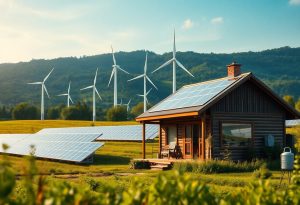What is Fracking: Understanding the Basics
If you’re curious about the nitty-gritty of the energy world, the term “fracking” might have come across your radar. But what is fracking? Officially known as hydraulic fracturing (a mouthful, I know), fracking is an ingenious technique used to extract natural gas and oil from deep under the Earth’s surface. And when I say deep, I mean really deep – like journey-to-the-center-of-the-earth kind of deep.
So, how does this work, you ask? Picture yourself trying to get the last bit of ketchup out of the bottle. What do you do? You add a little water, give it a good shake, and voila! The stuck ketchup is now free-flowing. Now replace the ketchup bottle with the Earth, the ketchup with natural gas or oil, and the water with a high-pressure mix of water, sand, and chemicals. That’s fracking for you!
Fracking is primarily employed to tap into hydrocarbon resources, specifically oil and natural gas, that are trapped in rock formations beneath the Earth’s surface. These formations, usually shale, are impermeable, meaning they don’t just let the oil and gas seep out. The principle behind fracking is to create a network of tiny cracks in these rocks where oil or gas is trapped, allowing them to escape to the surface. Think of it as a game of hide and seek, with oil and gas being the sneaky players that we manage to find out using fracking.
The Historical Backdrop of Fracking
“Everything old is new again,” as they say, and fracking is no exception. While it might seem like a modern phenomenon – what with all the debates and news coverage – the concept of fracking has been around since the 1940s. Yes, you heard it right! Fracking is not some whippersnapper technology. It’s been around longer than color TV!
The first experimental fracking operation was carried out in 1947 in Kansas, U.S.A. It wasn’t exactly successful, but hey, Rome wasn’t built in a day! The technique was further developed and fine-tuned over the next few years, with the first commercially successful operation carried out in 1949.
However, the technology only started gaining significant traction in the late 20th and early 21st century. Why the delay, you ask? Well, it’s the same reason why some of us take forever to get ready for a party. The conditions just weren’t right! Technological advancements, particularly in directional drilling, along with economic factors such as rising oil prices, made fracking a viable and attractive method for oil and gas extraction.
From then on, fracking operations have spread to numerous countries, shaping the energy landscape and redefining the geopolitics of oil and gas. It’s like the underdog contestant in a talent show that unexpectedly ends up winning the competition! It has undoubtedly had its share of controversies and criticisms, but that hasn’t stopped fracking from becoming an integral part of our global energy scenario.
The Science Behind Fracking: A Layman’s Perspective
Picture this: You’re at a birthday party. There’s this mouthwatering, multi-layered chocolate cake right in front of you. But here’s the catch – the layers are hidden beneath an unyielding crust of fondant. How do you get to the heavenly goodness trapped inside? Well, you could try smashing it with a fork, but that wouldn’t be very elegant, would it? Instead, you would gently carve through the cake, slice by slice, until you hit the layers.
Fracking operates on a similar principle. Consider the Earth’s crust as your cake. The crust consists of different layers, some of which hold oil and gas – the goodies we are after. But these layers aren’t always easy to access. In fact, they’re often buried under miles of rock. This is where fracking comes in.
In fracking, a well is drilled down into the ground, extending thousands of feet below the surface. This drill isn’t just a straight downward plunge – it can turn, twist, and angle its way to the desired location, much like a flexible straw navigating through a packed fruit punch bowl. This drilled well is the pathway we create to reach the oil and gas trapped deep within the Earth.
Once the well reaches the layer containing oil or gas (known as the production layer), the fun part begins. This layer, often made of shale rock, is then fractured – hence the term fracking. A high-pressure fluid, made of water, sand, and a cocktail of chemicals, is injected into the well. This fluid forces its way into the rock, creating cracks and fissures, almost like splitting open the fondant of our metaphorical cake. The sand in the fluid then props these fractures open, allowing the oil and gas to flow freely into the well, ready for extraction.
What is Fracking: The Fracking Process Step by Step
Initial Drilling
The first step of fracking is a bit like planning your route to a party – you need to know where you’re going. Geologists identify the location of the oil and gas deposits, which are often buried deep beneath layers of rock, and the drilling commences.
Using a rig, a hole is bored down into the Earth’s surface. This hole, known as the wellbore, is lined with steel casing to prevent it from collapsing and to protect groundwater. The drilling continues, often going thousands of feet deep and sometimes even making a horizontal turn to reach the resource-rich shale layers.
Fracturing Stage
Next up is the action-packed stage – fracturing. This is where the term “fracking” gets its name. A high-pressure fluid – mostly water, but also sand and a mix of chemicals – is blasted into the wellbore. Think of it as a supercharged garden hose, strong enough to crack open the rock formations. The pressure created by this fluid fractures the rocks, creating a network of tiny cracks and fissures. It’s like the rock layers are throwing open their doors and saying, “Come on in!”
Collection and Separation
Once the rocks have been fractured, the oil and gas hidden inside are now free to flow. These resources travel up through the wellbore to the surface. Here, we have our third stage: collection and separation. The oil and gas are separated from the fracking fluid and further processed to make them ready for use. Meanwhile, the used fluid, often referred to as flowback or wastewater, is either treated and reused, stored in wells, or disposed of, depending on local regulations.
So there you have it! From drilling to fracturing to collecting, the journey of fracking is a fascinating (and contentious) process. But the result? A steady flow of oil and gas that powers our homes, cars, and industries. Talk about power at your fingertips!
The Pros and Cons of Fracking
Like that friend who can be the life of the party but also turn into a one-man demolition crew after one too many, fracking is a mixed bag. It has its upsides – big ones at that. But it also comes with a handful of downsides that can’t be ignored. Let’s jump right in and see what these are.
The Upside
1. Economic Benefits: If there’s one thing that makes fracking the belle of the ball, it’s the economic benefits. By tapping into previously inaccessible oil and gas reserves, fracking has revitalized the energy industry in several countries, the U.S. being a prime example. It has led to job creation, cheaper energy prices, and a reduction in energy dependence on other countries. It’s like finding an ATM in your backyard that dispenses free cash!
2. Energy Security: Fracking helps countries extract more of their natural resources, making them less dependent on foreign oil and gas imports. This self-sufficiency not only improves energy security but also reduces the geopolitical complications that often come with international energy trade.
3. Bridge to Renewable Energy: Natural gas, a major product of fracking, is the cleanest-burning fossil fuel. It emits fewer harmful pollutants and less carbon dioxide compared to coal and oil. Thus, it’s often considered a “bridge fuel,” helping us transition from high-carbon energy sources to renewable ones. Kinda like a stepping stone across a crocodile-infested river.
The Downside
Despite the positives, fracking has a dark side too, much like your favorite superhero with a troubled past.
1. Environmental Concerns: The most glaring downside to fracking is the environmental impact. Fracking fluid contains chemicals, many of which are hazardous. Accidental spills can contaminate the soil, surface water, and groundwater. Plus, the high water usage in fracking operations puts a strain on water supplies. If Mother Nature were to grade fracking on its environmental report card, it wouldn’t be a pretty sight.
2. Earthquakes: Yes, you read that right. Fracking can induce seismic activities, known as “induced” or “man-made” earthquakes. These quakes are usually minor but can occasionally be strong enough to cause damage. If the earth shaking under your feet wasn’t part of your daily plans, you might want to take note.
3. Health Risks: Studies have suggested potential health risks for people living near fracking sites, including respiratory issues and low birth weights. It’s a bit like living next to a concert stadium – there’s potential for some serious side effects.
So, there you have it – the pros and cons of fracking, laid bare. It’s a powerful tool in our energy arsenal, but one that comes with some serious side effects. The ultimate question remains: Is the party worth the hangover? Only time will tell.
How Fracking Impacts the Environment
As it turns out, fracking and the environment have a bit of a love-hate relationship. Well, more of a “hate” relationship, to be honest. Like a bad roommate, fracking often leaves a messy trail in its wake, one that our dear old planet has to deal with. Let’s dive into the environmental impacts of fracking and see what the fuss is all about.
Water Quality and Usage
In the world of fracking, water is the lifeblood. A single fracking operation can use millions of gallons of water. That’s enough to fill a small lake or an absurd number of bathtubs. This massive water usage can strain local water supplies, especially in dry regions.
But it’s not just about the quantity of water used. It’s also about what happens to it. The water blasted into the fracking wells is mixed with a cocktail of chemicals. Some of these chemicals are benign, but others… not so much. Think of it as a soda pop – looks harmless, but is packed with all sorts of stuff you wouldn’t want in your body.
This chemical-laden water can pose a risk if it gets into the local water supply. This can happen through spills, leaks, or improper disposal of wastewater. Imagine making a cup of tea, only to find out the water has a slight taste of benzene – not very appetizing, is it?
Air Quality
Fracking doesn’t just have a rocky relationship with water; it also has a bone to pick with air. Natural gas, while cleaner-burning than coal or oil, can still contribute to air pollution. During fracking operations, methane – a potent greenhouse gas – can escape into the atmosphere. It’s like opening a fizzy drink and seeing the bubbles rush out, except these bubbles are harmful to the environment.
In addition to methane, fracking operations can also release volatile organic compounds (VOCs) and other pollutants that contribute to poor air quality. Long story short, if the air were to file a complaint, fracking would definitely be on the list.
Induced Seismicity
Yes, we’re back to the earthquakes. Fracking involves creating cracks and fissures deep in the Earth’s crust. This process can trigger seismic activities, known as “induced” earthquakes. Most of these quakes are minor, but some can be stronger, depending on the local geology and the specifics of the fracking operation.
Fracking-induced earthquakes are a bit like an uninvited party guest. They might not cause a scene every time, but when they do, it’s enough to make you think twice about your guest list.
In conclusion, when it comes to fracking’s environmental impacts, it’s safe to say that it won’t be winning any “Friend of the Planet” awards anytime soon. But like any powerful tool, it’s all about how we manage it. With careful regulation and oversight, the environmental footprint of fracking can be minimized. Now that’s a fracking good idea!
The Future of Fracking: A Balancing Act
Potential Improvements in Fracking Technologies
We have seen many advancements in fracking technologies that aim to make the process more efficient and less harmful to the environment. So, there’s hope on the horizon!
The Role of Legislation and Regulation
Strict regulations and careful monitoring can mitigate many of the environmental impacts associated with fracking. It’s like setting ground rules for a rowdy house party.
Conclusion
So what is fracking? Fracking, or hydraulic fracturing, is a technique used for extracting natural gas, oil, and other resources from deep underground. While it has revolutionized the energy sector, providing access to previously untappable reserves, it’s also a subject of intense scrutiny and debate due to its environmental and health implications.
The future of fracking is unclear. On one hand, it remains an essential component of the current energy landscape, offering a relatively low-cost source of energy and reducing reliance on imports. On the other hand, the environmental impact of fracking, including groundwater contamination, induced seismic activity, and substantial water usage, casts a long shadow over its long-term viability. Much like the climactic moments in a suspenseful movie, the future of fracking is a cliffhanger that hinges on societal choices, technological advancements, and policy directions we adopt today.
FAQs
Is fracking only used for oil and gas extraction?
While fracking is primarily associated with the extraction of oil and natural gas, its applications are more varied. Apart from hydrocarbons, fracking can also be used to tap into geothermal energy, where it helps in creating pathways for hot water or steam to flow from the Earth’s crust. Additionally, fracking techniques have been employed in certain mining operations to fracture rock and extract minerals.
Does fracking cause earthquakes?
Yes, fracking has been linked to induced seismic activities. While most of these are minor tremors, measuring less than 3 on the Richter scale, they can still cause concern, particularly in regions not accustomed to earthquakes. The injection of fracking fluid at high pressure into the Earth’s crust can disrupt the natural stress balance of rock formations, leading to tremors. Some studies also suggest that wastewater disposal wells, often used in the fracking process, may contribute to stronger seismic activities.
Are there alternatives to the water used in fracking?
Certainly, there are ongoing research and trials aimed at finding alternatives to water in fracking operations. Using water in large quantities is not only resource-intensive but also raises environmental concerns. Scientists and engineers are exploring the use of other substances, such as carbon dioxide and propane gel. These alternatives could potentially reduce the environmental impact of fracking, though each comes with its own set of challenges and trade-offs.
Is fracking a sustainable practice?
The question of whether fracking is a sustainable practice is a topic of much debate. On the positive side, fracking has substantially increased domestic energy production, reducing dependence on foreign oil and gas. This has economic benefits and can enhance energy security. However, the environmental costs, including potential water contamination, air pollution, and habitat destruction, make its long-term sustainability questionable. There are also social and health concerns, like the impact of fracking operations on local communities.
Can fracking be done anywhere?
No, fracking is highly dependent on geological conditions. The technique is most effective in areas with specific types of rock formations, such as shale or tight sandstone, that contain trapped natural gas or oil. The depth, porosity, and other geological factors determine whether fracking is feasible in a given location. Even within regions that have suitable rock formations, other considerations like proximity to populated areas, availability of water resources, and regulatory constraints can impact whether fracking operations are viable.




